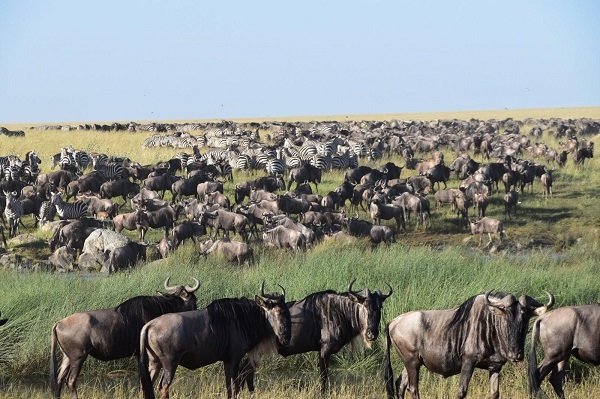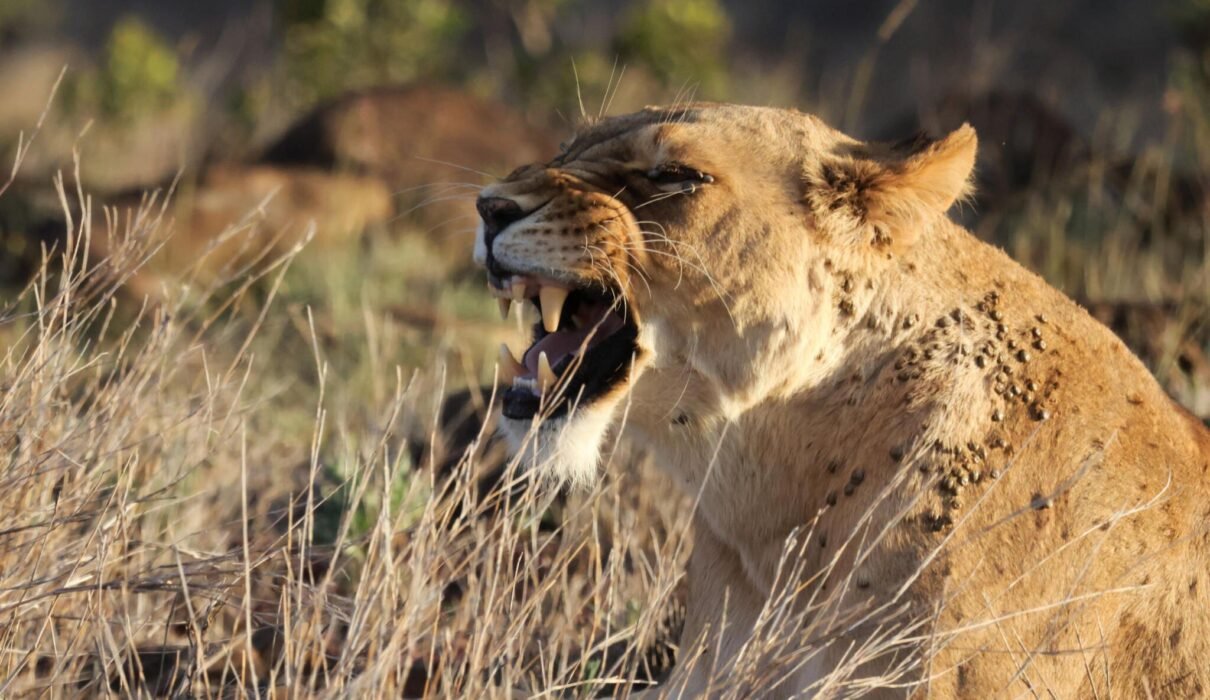Big Five in Tanzania :Tanzania is world-renowned for its incredible wildlife and safari experiences, with the “Big Five” being the ultimate safari bucket-list animals to see. These iconic animals—lions, elephants, leopards, buffaloes, and rhinos—are spread across Tanzania’s national parks and reserves. In this guide, we’ll explore where you can find the Big Five in Tanzania, how to maximize your chances of seeing them, and the best times to visit.
Start planning your safari to see the Big Five in Tanzania here
Big Five in Tanzania : What Are the Big Five?
The “Big Five” refers to the five most iconic and sought-after animals to see on an African safari. Historically, these animals were considered the most difficult to hunt, but today they symbolize Africa’s magnificent wildlife and are a must-see for any safari-goer.
- Lion: Known as the “King of the Jungle,” Tanzania has one of the highest concentrations of lions in Africa.
- Elephant: The African elephant, the largest land mammal, is frequently seen in Tanzania’s national parks.
- Leopard: Elusive and solitary, leopards are harder to spot but are found in many Tanzanian parks.
- Buffalo: The African buffalo is a powerful and unpredictable animal, often seen in large herds.
- Rhino: The black rhino is the most endangered of the Big Five and is primarily found in protected areas.
Learn more about Tanzania’s iconic Big Five species.
Big Five in Tanzania : Best Parks in Tanzania to See the Big Five
Serengeti National Park
Serengeti is one of the most famous wildlife parks in the world and is home to all of the Big Five. It’s particularly well-known for its lion population, as well as leopards that roam the trees along the Seronera River.
- Best For: Lions, leopards, elephants, and buffaloes.
- Highlight: The Great Migration offers a chance to see large herds of wildlife and predators in action.
Explore Serengeti’s Big Five safaris here.

Ngorongoro Crater
Ngorongoro Crater, a UNESCO World Heritage Site, is one of the best places in Tanzania to see the Big Five in a single day. The crater’s enclosed ecosystem is home to one of the highest concentrations of wildlife in Africa, including the endangered black rhino.
- Best For: Spotting all five in one location, especially rhinos and lions.
- Highlight: The crater floor is a perfect place to see wildlife up close due to its natural bowl shape.
Learn more about Ngorongoro Crater’s Big Five experience.
Tarangire National Park
Famous for its large elephant herds, Tarangire National Park is a fantastic destination to see these gentle giants up close. The park is also home to lions, leopards, buffaloes, and occasional sightings of rhinos.
- Best For: Elephants and buffaloes.
- Highlight: The dry season attracts massive herds of elephants to the Tarangire River.
Discover Tarangire’s wildlife and elephant herds.
Lake Manyara National Park
While Lake Manyara is smaller than some of Tanzania’s other parks, it is known for its tree-climbing lions and large elephant populations. The park is a great option for spotting elephants and lions, and birdwatchers will enjoy the flocks of flamingos.
- Best For: Lions, elephants, and buffaloes.
- Highlight: Tree-climbing lions and scenic landscapes.
Read more about Lake Manyara’s unique wildlife.
Selous Game Reserve (Nyerere National Park)
The Selous Game Reserve, now part of Nyerere National Park, is one of Africa’s largest reserves and offers an off-the-beaten-path experience for Big Five sightings. The reserve is particularly good for seeing leopards, elephants, and buffaloes.
- Best For: Leopards and elephants.
- Highlight: Remote and uncrowded, with diverse landscapes and wildlife.
Learn more about Selous Game Reserve.
Big Five in Tanzania : Best Time to See the Big Five in Tanzania
The best time to see the Big Five in Tanzania is during the dry season, which runs from June to October. During these months, animals gather around water sources, making them easier to spot. The short dry season, from January to February, is also a great time to visit, especially for those interested in seeing the Great Migration calving season in the Serengeti.
- June to October: Ideal for Big Five viewing as animals are more concentrated and vegetation is thinner.
- January to February: Great for the calving season, with plenty of predators on the hunt.
Find out more about the best time to visit Tanzania’s national parks.
Big Five in Tanzania : Conservation Efforts for the Big Five in Tanzania
Tanzania is deeply committed to the conservation of the Big Five, particularly the critically endangered black rhino and African elephant. Many of the national parks and reserves have anti-poaching programs and community-based initiatives to protect these animals from illegal hunting and habitat loss.
- Rhino Conservation: Ngorongoro Crater has become a sanctuary for black rhinos, offering them protection from poaching.
- Elephant Conservation: Tarangire National Park is known for its elephant conservation programs, which focus on protecting herds from poaching.
Read about Tanzania’s efforts to conserve the Big Five.
Big Five in Tanzania : Responsible Tourism: Protecting the Big Five
Tourism plays a significant role in supporting the conservation of the Big Five in Tanzania. By choosing eco-friendly tour operators and supporting local conservation projects, visitors can help protect these magnificent animals for future generations.
- Eco-Tourism: Choose operators that focus on sustainable and responsible safari practices.
- Conservation Fees: Park fees go towards maintaining the reserves and protecting wildlife.
Learn how to practice responsible tourism in Tanzania.

Big Five in Tanzania : Photography Tips for Capturing the Big Five
Photographing the Big Five can be a thrilling experience, but it requires patience and the right equipment. To capture stunning images of lions, elephants, and leopards, follow these simple tips:
- Best Time for Photos: Early morning or late afternoon offers the best light for wildlife photography.
- Camera Gear: Bring a zoom lens (200mm or higher) to get close-up shots without disturbing the animals.
- Stay Ready: Wildlife is unpredictable, so always have your camera ready for action.
Discover more safari photography tips.
Big Five in Tanzania : Combining Big Five Safaris with Other Wildlife Experiences
While the Big Five are the main attraction for many visitors to Tanzania, there’s so much more to see. Tanzania’s national parks are home to a wide variety of wildlife, including cheetahs, giraffes, zebras, wildebeest, and countless bird species. Combining a Big Five safari with other wildlife experiences will make your trip even more memorable.
- Great Migration: Witness the incredible spectacle of the Great Migration in the Serengeti.
- Birdwatching: Lake Manyara and the Ngorongoro Crater offer fantastic opportunities for birdwatching.
Read more about combining different wildlife experiences in Tanzania.
Big Five in Tanzania : Conclusion
Tanzania offers some of the best opportunities to see the Big Five in their natural habitats. Whether you’re visiting the Serengeti, Ngorongoro Crater, or Tarangire National Park, you’re in for a truly unforgettable safari experience. By planning your trip during the best times and choosing the right parks, you’ll maximize your chances of seeing lions, leopards, elephants, buffaloes, and rhinos in the wild.
For more information on planning your safari to see the Big Five, visit Kilimanjaro Climb Specialist or Eddy Tours & Safaris.

